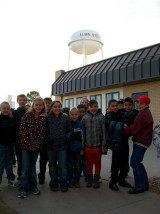-
Category 1
Selected in 2012
-
Grades: k - 6
School Setting: rural
Town Population: 181
Student Enrollment: 70
Student Demographics:
Black/African American: 0%
Teacher/Student Ratio: 1:12
White/Caucasian: 53%
Hispanic: 47%
Hawaiian/Pacific Islander: 0%
Asian: 0%
Native American: 0%
Other: 0%
% Reduced Lunch: 61%
% ELL Learners: 39%
Founded: 1930 -
PRINCIPAL:
LeAnn Smith -
CONTACT:
P.O. Box 38
Albin, WY 82050
307-245-4090
drsmith@mail.lrm2.k12.wy.us
Albin Elementary School
Albin, WY
A culture of collaboration is alive in the halls, classrooms, and hearts of Albin stakeholders. Parents, community members, and staff members join forces to provide resources necessary to meet students’ academic, social, and economic needs. We realize that school is about more than academic growth. It is about empowering students and their families to overcome obstacles in their lives.
- Describe specific programs in place to ensure that families are involved in the success of your school and students.
- There are many programs in place at Albin Elementary School that ensure that families are involved in the success of the school and its students. These include Parent Academy, Albin Parent Group, Academics Beyond the Classroom Preschool, and seasonal programs. Parent Academy is held one time per week during the second and third quarters, and it serves parents by helping them to understand what their children are learning at school, provide strategies they can use at home to improve the educational outcomes of their children, and covering various topics of interest in relation to child development, wellness, and education. Academics Beyond the Classroom Preschool convenes at the same time Parent Academy is held and its purpose is to help prepare preschool-age children ages two through five for kindergarten by providing opportunities for them to engage in fine- and gross-motor skill activities, literacy lessons, early learning skills, and technology-based instruction. The Albin Parent Group meets monthly and consists of parents who seek to improve the educational outcomes of students at Albin Elementary School by hosting family nights, providing incentives for students who demonstrate outstanding moral and academic achievement, and strive to create a sense of community with students, parents, and stakeholders. Various seasonal programs held include music concerts, student-led programs, art shows, and literacy nights. Collectively, these programs bring staff, students, and parents together and demonstrate that the work the children are doing is valuable and significant.
- Describe the most successful activity your school has initiated to strengthen the ties to your community.
-
Albin staff conducted a school-wide self-reflection survey in the spring of 2009. School improvement goal action research findings indicated a need for improved home/school communication with all stakeholders, including non-English speaking parents. To address this area of need and to contribute to the development of Albin Elementary School as a premier learning facility, the Albin Parent Academy was established. This group meets one hour per week during the 2nd and 3rd quarters of school. The main focus of the group is providing parent education and training with an instructional emphasis on how to reinforce learning objectives and provide enrichment of those concepts at home.
Through Albin Parent Academy, parents are encouraged to share ideas that work well with their children. Parents and teachers discuss research-based strategies in order to help their students succeed. Albin Parent Academy participants receive information regarding upcoming learning essentials, as well as outcome expectations in math and reading for each of their children. Information shared includes suggested games and study tips for each content area and teacher recommended websites that reinforce skills. In addition, they discuss the Spanish cognates for their new vocabulary. The Albin Parent Academy has served the parents of 33% of our entire student population, as well as parents from other schools in our district. The group is facilitated by all three of our Title I funded staff and is open to all parents.
Action research shows significant growth in student achievement for the students whose parents attended the Albin Parent Academy. For example, in 2012, 100% of the students whose parents attended Albin Parent Academy scored proficient or advanced on PAWS reading assessment. MAP Reading Spring 2012 data indicates that 92% of students, whose parents regularly attended parent academy, scored at or above the 40th percentile.
More recent survey data (spring 2011) indicated a positive appraisal of home/school communication. These current findings lead to the conclusion that the work between school staff and parents has been beneficial. In the future, school staff will continue to promote parent education and collaboration opportunities.
Albin Elementary has a steadfast belief in the value of parent involvement and we are willing to commit limitless energies to support this philosophy. - Describe your philosophy of school change or improvement.
- The philosophy of school change and improvement is based on relational leadership and shared responsibility. Albin teachers are frontrunners in education. Because of the level of knowledge and dedication the teachers possess, a shared leadership approach is successful in implementing change and improvement. Teachers strive to be well-informed in the area of educational pedagogy. They often initiate change themselves by presenting innovative ideas and working with other staff members to create positive school wide change for the benefit of their students. Moreover, the principal works to empower teachers while also being a catalyst for positive change and meaningful school improvement for the benefit of students. This behavior is evidenced by the principal’s investment in professional development opportunities and time spent collaborating with stakeholders to ensure successful implementation of effective practices. Certainly, Albin teachers and administration are concerted in their quest to implement positive school change and innovative school improvement initiatives.
- What are your school’s top two goals for the next year?
-
1. Albin elementary school will meet AYP in all categories in reading.
2. Albin elementary school will meet AYP in all categories in math. - What is the single most important factor in the success of your school that others could replicate?
-
Resolute dedication to the success of each individual student is the single most important factor in the success of our school. A culture of collaboration is alive in the halls, classrooms, and hearts of Albin stakeholders. Parents, community members, and staff members join forces to provide resources necessary to meet students’ academic, social, and economic needs. We realize that school is about more than academic growth. It is about empowering students and their families to overcome obstacles in their lives. Albin Elementary School strives to instill a desire for students, even during the most difficult times, to persevere and meet and exceed their innate potential.
There are many examples of methods Albin stakeholders use as they contribute to the important factor of meeting each student’s needs. In the area of academia, teachers are diagnostic and prescriptive in their approach to providing instruction that is custom made for each individual student’s learning needs. Students are provided with small group instruction which is aligned to their identified areas for growth. Progress is continually monitored. The school parent group sponsors educational activity nights to help make learning fun and to model beneficial learning activities to parents who may not have that skill set. Additionally, students who don’t have adequate resources are supported by staff and community members. If students are hungry or malnourished, they are given food to take home and share with their families. If students need coats, clothes, or even toys at Christmas, community members and local businesses make generous donations. When students do not have access to medical services, staff members help make resources available to them. Reading materials are also donated to students to provide them with opportunities to extend their learning beyond the walls of the school. Truly, the unwavering dedication to meet each student’s needs is the single most important factor in the success of Albin students and in the success of Albin Elementary School. - Describe the program or initiative that has had the greatest positive effect on student achievement.
- The implementation of “Target Time” has had a profound impact on student learning. Based on assessment data, small groups of less than six students are formed, targeting specific skills that were identified as common needs. Instruction is very explicit, and frequent progress monitoring is completed to assure that the interventions employed are having the desired effect. The groups are flexible, allowing students to move to other groups better suiting their current learning needs. This process is very fluid and constantly being driven by student data. Target time is the vehicle by which Albin Elementary implements Response to Intervention and it has had the most significant impact on our students’ achievement.
- Explain how Title I funds have supported your improvement efforts.
-
Title I funding is vital to the tradition of academic success for the scholars of Albin Elementary School. The mantra of “prescriptive instruction” for each student is provided by highly qualified staff members and specialists who make a difference through Title I funding. Additionally, Title I supported research-based programs provide explicit direct instruction to students with specific academic needs in both reading and math. These intervention programs continue to increase student achievement as measured by formative teacher made assessments as well as summative district and state assessments.
Furthermore, the most innovative family involvement and preschool programs at Albin Elementary are made possible through Title I funding. Continued extensive data analysis reveals on-going evidence of a positive impact on student achievement. For example, 100% of English language learners whose families participated in the weekly Albin Elementary parent involvement program achieved proficient or advanced proficient scores on 2012 state assessments.
Clearly, Title I funds allow Albin Elementary to meet and exceed the needs of a diverse and ever-changing student population. These funds will continue to play a key role in sustaining Albin’s position as a premier learning institution and National Distinguished Title I School. - Identify the professional development activities you use to improve the teaching portion of the teaching and learning process.
-
Albin Elementary School prides itself in being a premier learning institution. Students are challenged to deepen their thinking and understanding. The staff participates in countless professional development activities. Currently, the staff is deeply involved with the Public Education and Business Coalition’s work in Thinking Strategies. Albin Elementary School is developing lab classrooms to aide other teachers and schools as they, too, strive to implement strategies to increase student reading and thinking skills. The staff is becoming more immersed in the Thinking Strategies model through school-level strategy workshops hosted by our Title I teacher as well as a PEBC consultant.
Albin teachers also value furthering their own education for the benefit of improved student learning. At this small rural school, an astounding 21% of the teachers are Nationally Board Certified! Numerous teachers have earned master’s degrees while our principal holds a doctorate in educational leadership and policy studies. Teachers attend conferences and trainings to further improve their knowledge of innovative approaches for Albin’s diverse population of students.
Teachers value their time in Professional Learning Communities as they delve into book studies, collaborate with one another on ideas for teaching students in more effective ways, and combining knowledge when analyzing students’ test data. - Describe how data is used to improve student achievement and inform decision making.
- After both formal and informal data are collected via formative and summative assessments, teachers, the principal, and/or instructional paraprofessionals analyze it. This analysis is conducted during informal collaboration times, professional learning community meetings, staff meetings, and at-risk or building intervention team meetings as appropriate. In addition, students analyze their own assessments results and compile them in portfolios, which are shared with their parents during student-led conferences. These processes improve student achievement and inform decision making by helping students to understand where they are and where they are going and guiding teachers as they write SMART (specific, measurable, attainable, realistic, and time-bound) goals for every student, plan and implement instruction, provide differentiation and enrichment, and serve students through Response to Intervention. Decisions are based upon the amount of progress students are making in addition to the extent to which they are demonstrating proficiency. When there is a deficit in either area, the staff refers to collected data to come up with plans to make necessary changes in order to meet students’ needs.
- Describe your school culture and explain changes you’ve taken to improve it.
-
Albin Elementary has a very diverse and rural school culture. The English Learner percentage of the student population has been steadily increasing over the past 10 years. Albin staff strives for all students to achieve academic success, and for EL students to have the same access to learning as their monolingual peers. The school’s EL Specialist researched interventions that are successful with ELs, such as Step Up to Writing, the Sheltered Instruction Observation Protocol (SIOP) Model, and Classroom Instruction that Works for ELLs. Albin’s principal helped to obtain training for all staff in these interventions through outside resources and through the EL Specialist. In addition, staff members continue to work to increase parental support for EL students. This has been most successful through the Albin Parent Academy (APA). The Title I teacher, EL Specialist, and Spanish language paraprofessional work together to hold weekly APA meetings for parents to help them successfully work with their students at home. This not only ensures parents have increased academic assistance, but it also helps support parents as they learn to navigate the American school system.
The majority of Albin students are from farms or ranches. Some students travel upwards of 30 miles to attend school. Staff members work to build students’ background knowledge through reading, educational field trips, pen pals, and virtual tours. Financially, students from this rural economy are generally in the lower income brackets. To ensure that staff members are able to effectively instruct and relate to students of poverty on a deeper level, staff members studied the research of Dr. Ruby Payne in Professional Learning Communities and in school level workshop sessions. Understanding poverty guides much of the cultural considerations of school staff.
The most important cultural aspect of Albin Elementary school is that no matter what successes or challenges students face, once they become a wildcat, they are forever part of a supportive and encouraging school family. Students and staff alike support each other through difficult times and celebrate each other’s victories!
Stats
-
Category 1
Selected in 2012
-
Grades: k - 6
School Setting: rural
Town Population: 181
Student Enrollment: 70
Student Demographics:
Black/African American: 0%
Teacher/Student Ratio: 1:12
White/Caucasian: 53%
Hispanic: 47%
Hawaiian/Pacific Islander: 0%
Asian: 0%
Native American: 0%
Other: 0%
% Reduced Lunch: 61%
% ELL Learners: 39%
Founded: 1930 -
PRINCIPAL:
LeAnn Smith -
CONTACT:
P.O. Box 38
Albin, WY 82050
307-245-4090
drsmith@mail.lrm2.k12.wy.us







